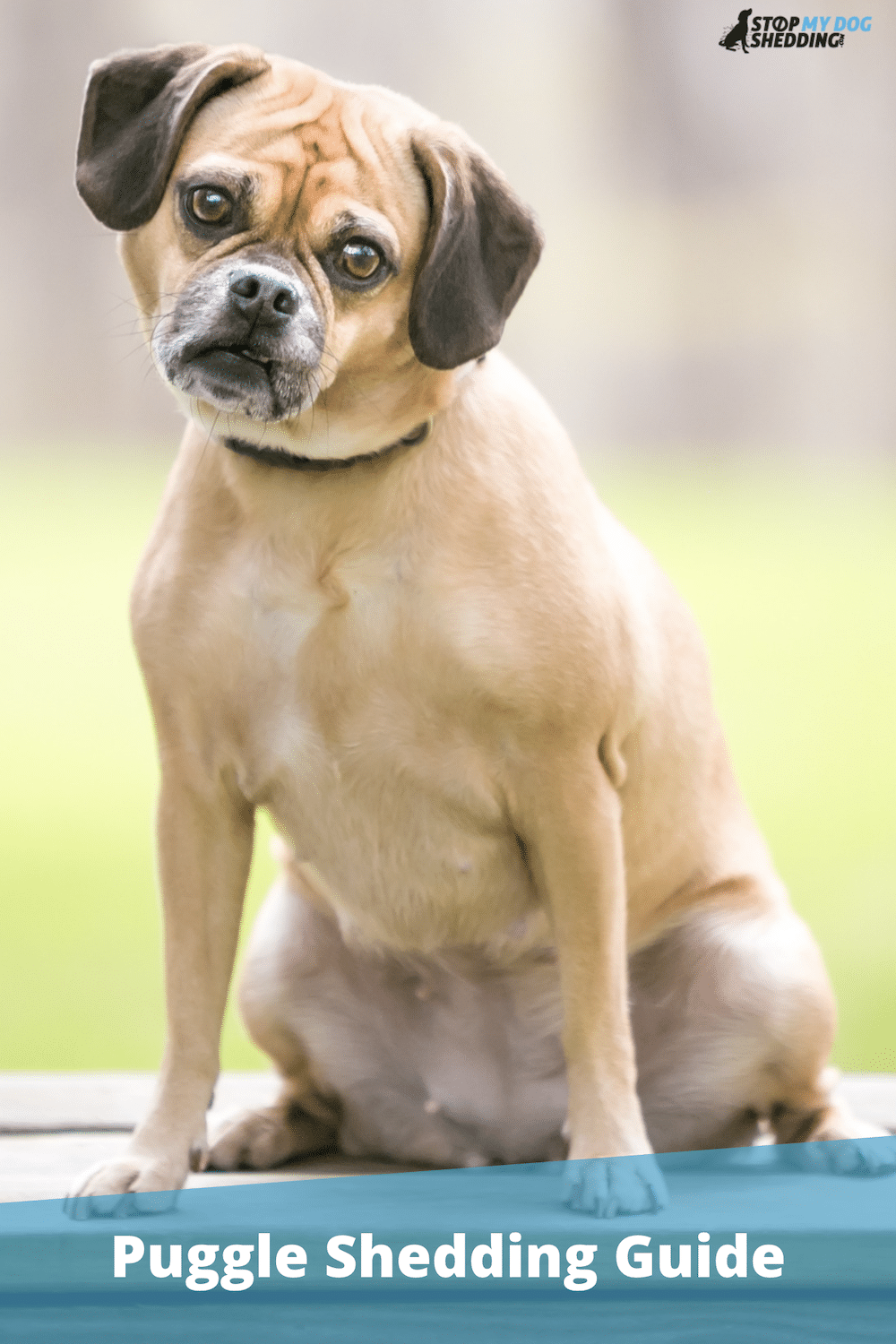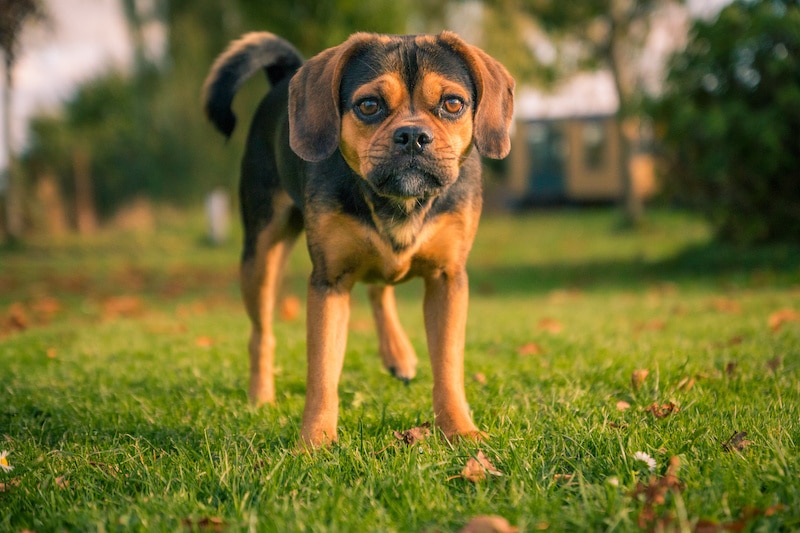The Puggle is a hybrid of the Beagle and Pug and was bred as an adorable companion pup. Puggles are also supposed to be healthier than both breeds they come from.
How are they on the shedding front?
Puggles are considered moderate shedders. Their parents, the Beagle and Pug, are mid-to-heavy shedders, though. So, generally speaking, if your Puggle is more Beagle than Pug, the dog might shed less, and if it’s more Pug than Beagle, expect more shedding.
This guide to Puggle shedding and grooming can help you decide whether adopting a Puggle is the right choice for you. I’ll also include tips on getting the shedding under control.
Puggle Shedding
As a crossbreed, whether your Puggle will shed to excess or just a reasonable amount all comes down to genetics.
Let’s take a closer look at the parent breeds of the Puggle, as I’ve discussed both breeds on the blog before.
The Pug, which is where the “Pug” part of the Puggle name comes from, is a pretty heavy shedder. This is very surprising considering the Pug is such a small dog with a short coat. But small, short-haired dogs can drop a lot of fur, and the Pug is one of them.
The reason the Pug sheds to excess is in part because the breed is double-coated. A double-coated dog has an undercoat that acts as an insulating layer and an outer coat that allows dirt and grime to slide right off.
Double-coated dog breeds shed with the seasons, so blowing fur is especially severe ahead of the winter and the summer.
The Pug is a bit of an anomaly, though. Despite that he’s double-coated, Pugs shed lots regardless of the season.
Now let’s look at the other parent of the Puggle, which is the Beagle.
I wouldn’t call Beagles light shedders, but compared to Pugs, they sure are.
Beagles release fur throughout the year, but not mountains of it. Well, until their seasonal shedding begins, that is.
Yes, Beagles shed seasonally too. So you’ll typically notice more hair drop from the Beagle during the winter and the summer.
Now that you understand the Puggle’s parents a bit better, you can see where this crossbreed is a mixed bag regarding its own shedding habits.
If your Puggle has more Beagle DNA than Pug, then you can expect seasonal shedding and moderate shedding during the rest of the year.
However, for the Puggles that take more after their Pug parent, their shedding will be consistent and messy all the time.
Regardless, Puggles probably aren’t the ideal breed if you’re looking for the lowest-shedding dog possible. Nor are they a hypoallergenic breed. So if that’s what you’re looking for, then breeds like the Italian Greyhound, Bichon Frise, or Toy Poodle are better alternatives.
That said, there are a few caveats to this.
First, as mentioned, how much hair your Puggle drops will depend on the individual dog. It’s tough to say how heavily any crossbreed will shed as it depends on the parents. So, when adopting hybrid breeds like the Puggle, it’s always worth choosing a reputable breeder so you can ask about the Puggle’s lineage and therefore get a better of what to expect.
Second, even though the rate at which Puggles shed is typically higher than average, they’re not large dogs, so there’s only so much hair they can drop. And because they have short coats, the fur they drop isn’t as noticeable as longer-haired breeds that shed.
Third, it is possible to reduce the shedding significantly, and given how easy they are to groom, it doesn’t take a lot of time or effort to keep your home relatively hair-free.
Grooming Your Puggle
One of the great things about the Puggle is that it’s not a high-maintenance dog when it comes to grooming. And it takes after both of its parents in this respect.
Puggles have short coats just like dear ol’ mom and dad. One of the benefits of short dog hair is that it’s less prone to tangles, mats, and knots.
Even still, since your Puggle sheds quite a bit, you’d have to commit to brushing the dog often. If your Puggle sheds all the time, then brush it daily. If your Puggle has periods of the year where it sheds less often, you should brush the dog maybe every other day or every couple of days.
A bristle brush suits the Puggle’s short fur, as does a rubber hand brush. Here’s a video I found on Youtube showing Puggle grooming so you can see how it’s done:
The breed standards of a Puggle are nothing outrageous like you’d see in a Poodle or Lakeland Terrier, which also saves you time when grooming your precious small dog. You’d only have to brush the Puggle and trim the dog every couple of months.
Bathing your Puggle is an integral part of its grooming routine. At least every month, you should plunk your Puggle in the sink or bathtub to clean them thoroughly. You’ll need a good-quality dog shampoo and conditioner for bathing.
Always use lukewarm water to avoid scalding your dog, and ensure they have a mat to stand on as well. Keep shampoo and conditioner away from your Puggle’s face, or bathing him in the future might be a more significant challenge.
Make sure that you don’t bathe your Puggle too often, though, as it can dry out the dog’s skin. And dry skin is not only bad for your dog; it can increase shedding.
Reducing Excessive Puggle Shedding
While you can’t stop Puggle shedding entirely, you can reduce it to the point it’s hardly noticeable, regardless of whether your Puggle is more Pug or Beagle.
First, I always recommend assessing your dog’s diet. If your Puggle is nutrient-deficient, he’ll shed more. That’s also true if your Puggle has allergies to ingredients in its food.
In either scenario, it’s worth taking your dog to the vet for an evaluation and possibly some allergy testing. Put your Puggle on a balanced diet without allergens, and some of its excessive fur-dropping might stop. Check out our list of top-rated dog foods for shedding to learn more.
You should also check your Puggle for fleas, ticks, and other parasites that can increase the dog’s rate of shedding. These parasites are easier to see in the short fur of a Puggle compared to other breeds, but if your dog has darker fur, you might not notice fleas and ticks.
Brushing your Puggle is one of your best defenses against shedding, and I can’t stress that enough. Regular brushing collects the dead dog fur before it comes off your Puggle.
You also stimulate the skin and increase the spread of oils when you brush. And since dry skin can increase your Puggle’s rate of shedding, this makes brushing well worth the effort.
Here are some other suggestions for controlling your Puggle’s shedding:
- Consider omega-3 supplements
- Exercise your Puggle to reduce its anxiety and stress
- Put your Puggle in a dog shedding onesie
Check out our complete shedding guide to learn more about each method. That guide gives you everything you need to win the battle against loose dog fur, once and for all.
Is a Puggle Right for You?
If you’re still debating whether you should adopt a Puggle, allow me to help.
The crossbreed Puggle was created in the United States as a companion dog. The breeders who dreamed the concept of the Puggle did so to make him healthier and more amiable than the Beagle and the Pug.
For instance, the Puggle doesn’t have a scent drive like the Beagle does, nor is the Puggle highly energetic and prone to howling. In addition, puggles have fewer breathing troubles than the brachycephalic Pug does.
I should note that depending on the Puggle’s parents; the dog can develop all the issues above, which is just another reason to please choose your breeder carefully.
The Puggle has a great personality and is often described as friendly and intelligent. He’d make a great companion for many families.
Do you live in an apartment?
Puggles are a great size for apartment dwellers, as the dog is about 15 inches tall and 30 pounds. Homeowners should have more than enough room for this dog to run, play, and tire itself out.
When spending any outdoor time with the Puggle, keep him on a short leash, quite literally. Puggles love to run off, and since they’re not super-easy to train, your dog might not respond to your commands.
Puggles love big, though, and that includes children and other animals in the house. That said, socializing your Puggle with your human and pet family members is always recommended.
Despite that the Puggle isn’t supposed to howl as Beagles do, as I mentioned before, sometimes those Beagle traits come through, which will lead to some howling. So Puggles can be very vocal and bark loudly. But with proper training, it’s not difficult to get under control.
Recommended: Go here to see our top-rated dog hair blow dryers
The Bottom Line
The Puggle is a mid-sized hybrid of the Pug and Beagle that was bred to be a cute family pet without as many health issues or a strong prey drive.
Its traits are a mixed bag depending on which parent the Puggle takes after more. For the dogs with a stronger Pug side, expect frequent shedding throughout the year. On the other hand, if your Puggle is more like its Beagle parent, then the shedding will be moderate.
Brushing your Puggle often and bathing him no more than once a month are great ways to control shedding. It’s also worth seeing your veterinarian to get your Puggle’s health evaluated because diet issues, fleas, and other parasites can increase your dog’s shedding.













Please note: By submitting a comment using the above comment form, you confirm that you agree with the storage and handling of your data by this site as detailed in our Privacy Policy.